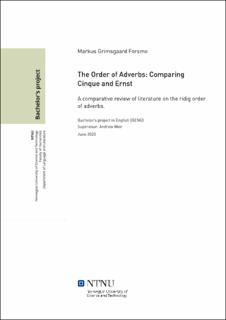| dc.contributor.advisor | Weir, Andrew | |
| dc.contributor.author | Forsmo, Markus Grimsgaard | |
| dc.date.accessioned | 2020-07-29T16:00:56Z | |
| dc.date.available | 2020-07-29T16:00:56Z | |
| dc.date.issued | 2020 | |
| dc.identifier.uri | https://hdl.handle.net/11250/2670432 | |
| dc.description.abstract | I en grunnleggende engelsk setningsoppbygging, må adverbet always valigvis komme før adverbet completely, med mindre setningsstrukturen har blitt endret gjennom syntaktisk bevegelse. Spørsmålet om hvordan å redegjøre for denne type adverbsrekkefølge har ført til to ulike hold innen det lingvistiske fagmiljøet: en side favoriserer den tradisjonelle tilnærmingen med attributter; den andre foretrekker en mer «restriktiv» syntaks. Rundt århundreskiftet, vokste det frem to innflytelsesrike tilnærminger: med hans universalhierarki av funksjonelle projeksjoner argumenter Guglielmo Cinques (1999) for en tilnærming hvor adverbene spesifiserer fuksjonelle projeksjoner, mens i Thomas B. Ernst 2002 sin «Scope theory», gir han sin tilslutning til den tradisjonelle hypotese om attribusjon gjennom å argumentere for en mer sematikk-fokusert tilnærming til adverbenes rekkefølge. Bøkene hvor disse to synene blir etablert – Adverbs and Functional Heads (1999) og The Syntax of Adjuncts (2002) – er hovedfokuset i denne oppgaven. Cinque 1999 sin tilnærming viser seg å gjøre det mulig å forutse og forklare adverbenes rekkefølge gjennom en rigid organisering av adverb basert på en mangfoldig ordstillingsrekkefølge, men hindres av en mengde faktorer, hvorav spekulative frasebevegelser skiller spesielt ut. Enst 2002 sin redegjørelse klarer også å forutse og forklare rekkefølgen. Dette gjør han ved bruk av flere semantiske prinsipper og noen få syntaktiske, kun holdt tilbake av vanskeligheten i å bevise den abstrakte teorien gjennom empiri. Det at Ernst 2002 sin teori er mer fullkommen enn Cinque 1999 sin, gjør at denne sammenligningen foretrekker Ernst sin «Scope theory» over Cinques universalhierarki. Dog er begge teoriene troverdige. | |
| dc.description.abstract | In basic English clauses, the adverb always must usually come before the adverb completely, unless the sentence structure has been altered through some kind of movement operation. The question of how to account for this kind of adverb ordering has led to two camps within the linguistics community: one favouring the traditional adjunction approach; the other preferring a more ‘restrictive’ way of representing the syntax of adverbs. Around the turn of the millennium, two influential approaches emerged: Cinque 1999’s universal hierarchy of functional projections, arguing for an approach in which adverbs are located in specifier positions of functional projections, and Ernst 2002’s Scope theory, giving its support to the traditional free adjunction hypothesis by arguing for a more semantic-oriented approach to adverb ordering. The two books in which these were established – Adverbs and Functional Heads (1999) and The Syntax of Adjuncts (2002) – are the main focus of this thesis. Cinque 1999’s approach is found to be able to predict and satisfactorily account for the order of adverbs through a proposed rigid order of adverbs on the basis of a rich functional sequence, but is held back by a number of factors, most notably unsubstantiated phrasal movement. Conversely, Ernst 2002’ approach manages to predict and account for adverb ordering through several semantic principles and some syntactic ones, only held back by the difficulty in explicating its cognitive nature for empirical evidence. The comparison thus favours Ernst’s free adjunction approach over Cinque’s adverbs-in-specifier approach but also considers both plausible. | |
| dc.publisher | NTNU | |
| dc.title | The Order of Adverbs: Comparing Cinque and Ernst | |
| dc.type | Bachelor thesis | |
